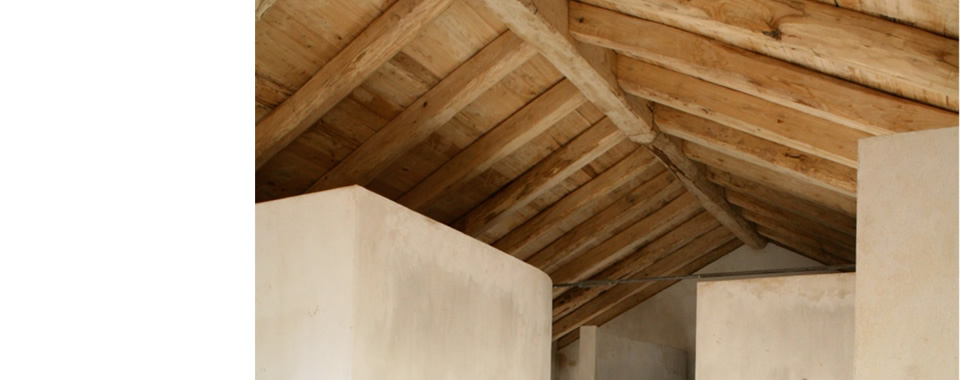

Score - Sustainable Construction in Rural and Fragile Areas for Energy efficiency
Guidelines for Integrated territorial Planning:
Biomass
The following guidelines come from a deep analysis of case studies, norms and regulations, in relation to the local level. This analysis is summarized in a card that can be downloaded in italian language.The use of Biomass has a very wide range, from the heating of the dwelling up to the scale of the neighborhood and the city. it is the generation of electricity through combustion or gasification processes. Very popular in other regions of Italy, in Liguria has little significant applications, although there is a strong potential of material given by the extensive forests.As for the heating of small-scale (flat/apartment) there are no particular problems in their use and there is also a good spread in rural and mountainous areas (e.g. the case studies Restructuring forestry barracks for tourism in the area of Monte Penna and the Farm holiday reorganization.
The diffusion of Biomass might increase thanks to:
- can build adequate storage rooms, with the adjustment of the local zoning and landscape regulations especially in case of restructuring works in urban areas
- recognize the use of biomass in the Ligurian energy certification system “Celeste” , software that does not recognize the value of the use of biomass stoves and boilers
- release even small and manageable packs, as in the case of wood pellet
As for heating and electricity systems bigger than 1-10MW, we have analysed the following case studies:
- heating system of the school in Rezzoaglio (GE) (p 150 Kw th)
- district heating systems in Valle Stura (GE) (Masone 1300 kW th, Rossiglione 1000 kW th, Campo Ligure 700 kW th)
- district heating systems in Carcare (SV) (850 kW th)
- heating system of a manufacturer of pallet, Mallare (SV) (3MW th)
- projects for electricity in Ferrania (10 MW e)
According to the experts of the field that we consulted the weaknesses are:
- lack of information and involvement of local people
- lack of specific preparation of technics
- lack of consideration of environmental resources and the presence of forestry companies in the area (Val Bormida, Savona)
- lack of guidelines for the preparation of announcements for biomass systems
Particularly, is strategical for the power plant to locate a "square" as a logistics infrastructure able to realize a direct relationship between power plant and local suppliers. In this way you can select the wood for the various uses of the chain (fuel, carpentry etc.) and it is also easier to organize to obtain biomass from maintenance works of public parks or private gardens. For the economic use of our woods is also necessary revise the national and local forest regulations. Nowadays it's usual to assimilate interventions in woods to the ones in building contexts causing many difficulties with implementations
Indication for the Bio-construction Action Plan
To further increase the right use of biomass it must:
- realize pilot systems and apply them in convenient contexts. For example in agricoltural contexts (such as greenhouses, carpentries...) and inland valleys for heating and to produce electric energy.
- create local events to link all the stakeholders
- realize infrastructure (areas and management) to strengthen the timber chain and to increase the ecological use of waste vegetable products
- update urbanistic systems to stimulate the diffusion of these projects (awards for areas and compatible uses)
- revise the national and local forest regulations
- adapt the so called Celeste system (a specific software used by Regione Liguria for energetic certification) so that it can admit the use of biomass boilers
Actually this kind of boilers are described as traditional boilers fired by renewable sources. The Celeste system does not allow the data acquisition in case of wood pellet stoves.
Possible criteria for MED bio–housing quality certificate
In the “Protocollo Itaca”, italian version of “Green Buildings Challenge”, (Itaca semplified 2004, Itaca residential 2011) the use of biomass is discussed in the B15 part; this scheme relates to the use of primary energy for heating. Criteria for the use of biomass can also be found in the C1 part, the one that relates to the CO2 emission.
In these protocols the theme of the use of biomass to produce electric and termic energy is discussed for what concerne:
- the positive effects for the territory (use of the wood, reduction of the costs and of traffic volumes for the supply of raw material)
- reduction of emission in the atmosphere
- reduction of the costs of energy
- use of natural and local materials
The advantage of the use of biomass is strictly connected to the passive performances of buildings (thermic insulation) combined with heating systems (for radiance) and with the possibilities to use local materials (within 60 km).
Case studies
- Restructuring forestry barracks for tourism, Monte Penna (GE);
- Farm holiday reorganization, Borzonasca (GE);
